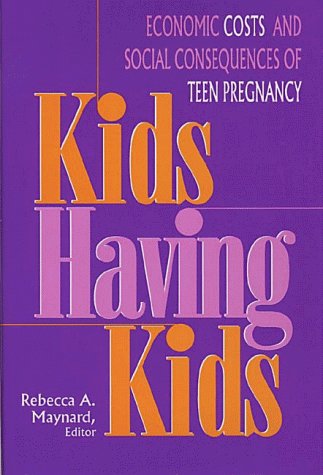Kids Having Kids: Economic Costs and Social Consequences of Teen Pregnancy - Hardcover

"synopsis" may belong to another edition of this title.
THE STUDY, THE CONTEXT, AND THE FINDINGS IN BRIEF
By Rebecca A. Maynard
Each year, about 1 million teenagers in the United States approximately 10 percent of all 15- to 19-year-old women become pregnant. Of these pregnancies only 13 percent are intended. The U.S. teen pregnancy rate is more than twice as high as that in any other advanced country and almost 10 times as high as the rate in Japan or the Netherlands. About a third of these teens abort their pregnancies, 14 percent miscarry, and 52 percent (or more than half a million teens) bear children, 72 percent of them out of wedlock. Of the half a million teens who give birth each year, roughly three-quarters are giving birth for the first time. Over 175,000 of these new mothers are age 17 or younger.
Teen pregnancy has come very much into the public debate in recent years, at least partly as a result of three social forces. First, child poverty rates are high and rising. Second, the number of welfare recipients and the concomitant costs of public assistance have risen dramatically. And third, among those on welfare we see a much higher proportion of never-married women, younger women, and women who average long periods of dependency. No work to date, however, has made a comprehensive effort to identify the extent to which these trends are attributable to teen pregnancy per se, rather than to the wider environment in which most of these pregnancies and the subsequent child rearing take place, or to look at the consequences of teen pregnancy for the fathers of the children and for the children themselves. Kids Having Kids begins to fill this gap.
GUIDANCE FROM PRIOR RESEARCH
The Kids Having Kids research was undertaken in the context of literature describing trends in adolescent childbearing and factors that lead to or exacerbate these trends and their consequences. Aspects of the literature have helped shape this research. So, too, the results of the Kids Having Kids research underscore the emerging consensus that the poor outcomes observed for teenage parents and their children are the product of myriad factors, among which early childbearing is only one.
FACTORS RELATED TO THE TRENDS IN TEEN BIRTH RATES
The likelihood that teenagers engage in unprotected sex, become pregnant, and give birth is highly correlated with multiple risk factors. These factors include growing up in a single-parent family, living in poverty and/or in a high-poverty neighborhood, having low attachment to and performance in school, and having parents with low educational attainment (Moore, Miller et al. 1995). For example, teenagers living in single-parent households are one and a half to two times more likely to become teenage parents than those in two-parent families (Zill and Nord 1994). Probabilities increase for those with low aspirations and low aptitude test scores. More important, each of these factors increases not only the risk of teen parenthood but also many other negative outcomes, such as poor school performance, weak social skills, and low earnings potential.
CONSEQUENCES FOR ADOLESCENT CHILDBEARING
Earlier studies have found that adolescent mothers have high probabilities of raising their children in poverty and relying on welfare for support. More than 40 percent of teenage moms report living in poverty at age 27 (Moore et al. 1993). The rates are especially high among black and Hispanic adolescent mothers, more than half of whom end up in poverty and two-thirds of whom find themselves on welfare. Indeed, a recent study found that more than 80 percent of young teen mothers received welfare during the 10 years following the birth of their first child, 44 percent of them for more than 5 years (Jacobson and Maynard 1995).
This results from a combination of factors, including their greater-than-average income needs to support themselves and their children, lower earning potentials, and more limited means of support from other sources, including male partners. Adolescent mothers have an average of six-tenths more children than do older childbearers, and they have their children over a shorter time span. This fertility pattern both increases their income needs over the long haul and adversely affects the likelihood that they will complete high school and have decent earnings prospects (Nord et al. 1992; Rangarajan, Kisker, and Maynard 1992; Grogger and Bronars 1993; Geronimous and Korenman 1993; Hoffman, Foster, and Furstenberg 1993; Ahn 1994).
Although past literature is consistent in pointing out these poor outcomes for adolescent parents and their children, it is less clear how much of the poor outcomes observed for adolescent parents and their children is directly attributable to early childbearing as opposed to other background and contextual factors common among young mothers. The accumulating evidence suggests that at least half and plausibly considerably more of the poor outcomes can be attributed to factors other than the early childbearing-factors that in many cases may have contributed to the teen becoming a parent (Wolpin and Rosenzweig 1992; Bronars and Grogger 1994; Geronimus, Korenman, and Hillemeier 1994; Haveman and Wolfe 1994; Hoffman, Foster, and Furstenberg 1993). Four such factors are particularly noteworthy.
"About this title" may belong to another edition of this title.
- PublisherUrban Inst Pr
- Publication date1997
- ISBN 10 0877666547
- ISBN 13 9780877666547
- BindingHardcover
- Edition number1
- Number of pages361
- EditorMaynard Rebecca A.
Buy New
Learn more about this copy
Shipping:
US$ 6.65
Within U.S.A.
Top Search Results from the AbeBooks Marketplace
Kids Having Kids: Economic Costs and Social Consequences of Teen Pregnancy
Book Description Hardcover. Condition: New. Edition Unstated. The book is New, Excellent condition. Quantity Available: 1. Category: Parenting & Childcare; Economics. ISBN: 0877666547. ISBN/EAN: 9780877666547. Pictures of this item not already displayed here available upon request. Inventory No: 1560789070. Seller Inventory # 1560789070

